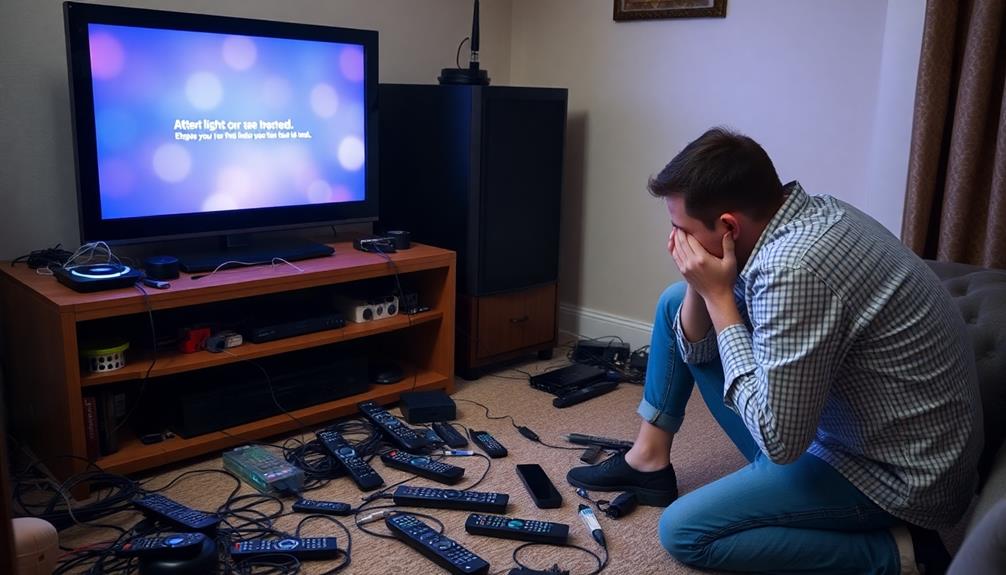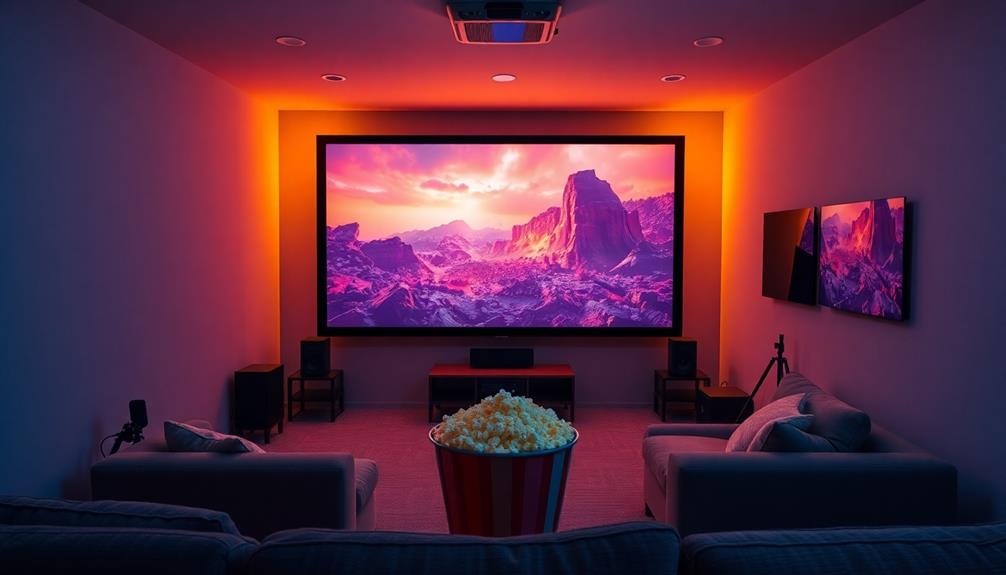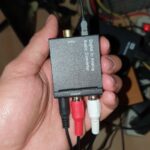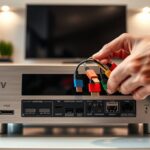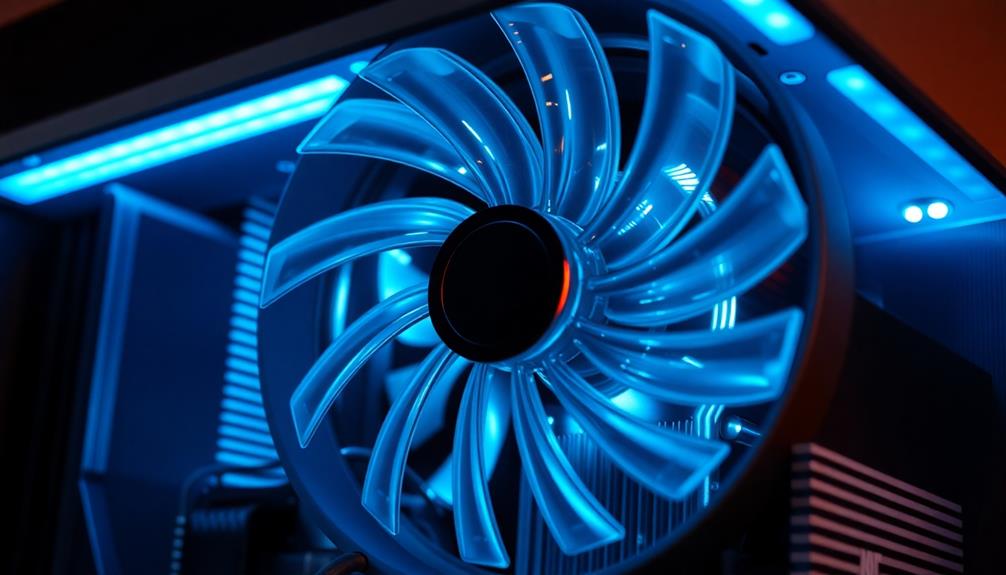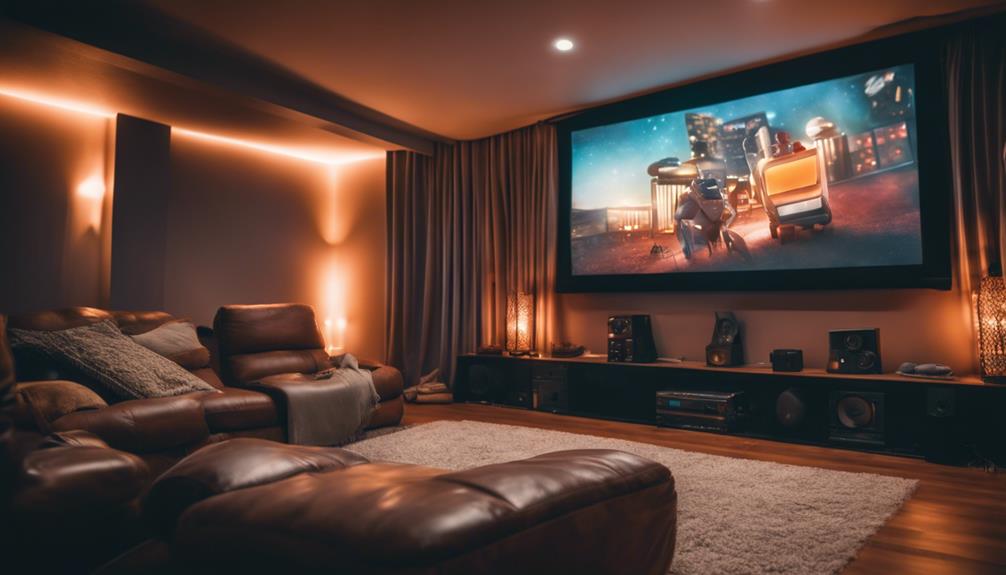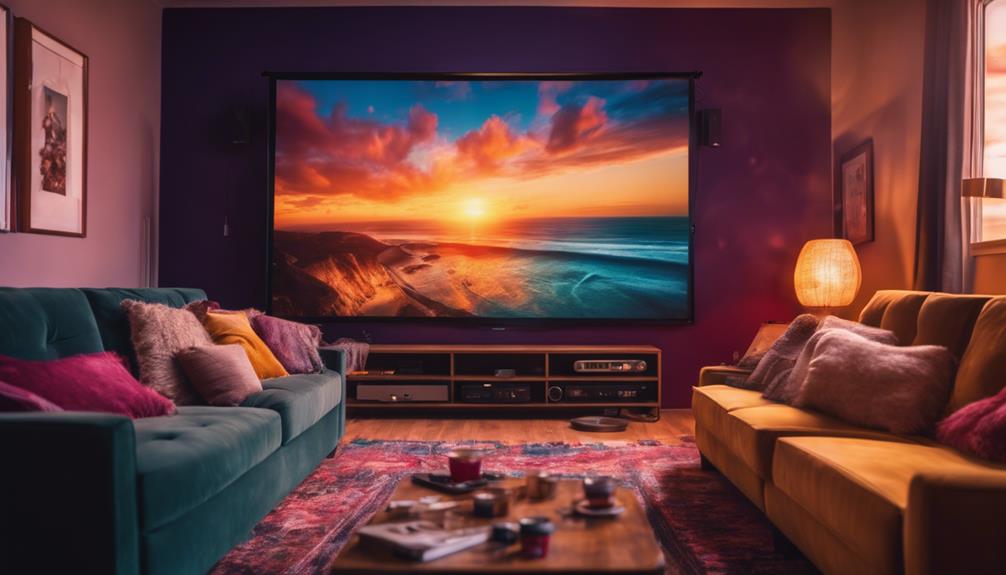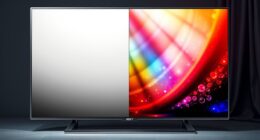When troubleshooting common home theater connectivity issues, start by checking all cable connections and ensuring they're secure and undamaged. Update your device firmware regularly to maintain compatibility. If you're facing sound quality problems, verify audio connections and adjust the settings on your soundbar or receiver. For video issues, confirm that your resolution settings match your display's capabilities. Don't forget to check your internet connection if streaming is involved; a stable Wi-Fi or wired connection improves performance. Address these areas, and you'll enhance your system's functionality. Keep going to find more tips on optimizing your home theater experience!
Key Takeaways
- Ensure all audio and video cables are securely connected and undamaged to prevent signal loss and sound quality issues.
- Check compatibility of devices and streaming services, verifying HDMI specifications and audio format support for optimal performance.
- Regularly update device firmware to maintain compatibility and improve performance across your home theater system.
- Optimize speaker placement by positioning them at ear level and avoiding corners to enhance sound distribution and reduce distortion.
- Test remote control functionality by replacing batteries, ensuring a clear line of sight, and checking for interference from other electronics.
Sound Quality Issues
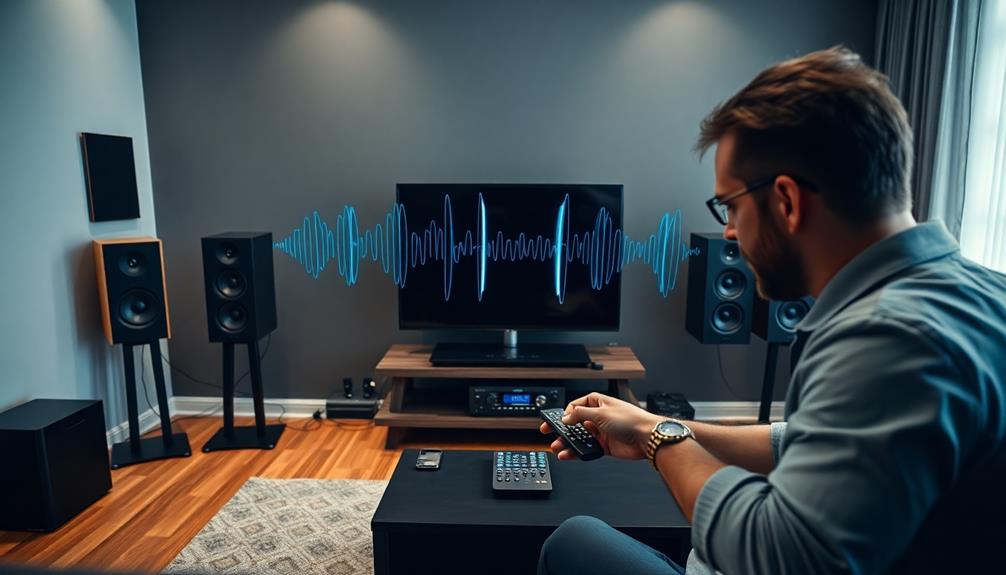
Many home theater enthusiasts encounter sound quality issues that can detract from their viewing experience. These problems often arise from improperly connected or damaged audio cables. You should check all speaker connections to verify they're secure and inspect the cables for any physical damage.
Additionally, confirming your projector is compatible with your audio system is essential for achieving high-quality sound, especially when using high refresh rates for gaming or watching movies in stunning detail with the right projector type.
Next, explore your audio settings on the soundbar or receiver. Verify the volume levels and equalizer settings are configured correctly for maximum sound performance. If you're using a surround sound system, confirm that your source material supports 5.1 or 7.1 surround sound; otherwise, you won't get that immersive audio experience.
If you notice poor sound balancing, you can rectify this by adjusting the receiver's built-in equalizer and recalibrating speaker levels to achieve a more uniform audio output.
Video Quality Problems
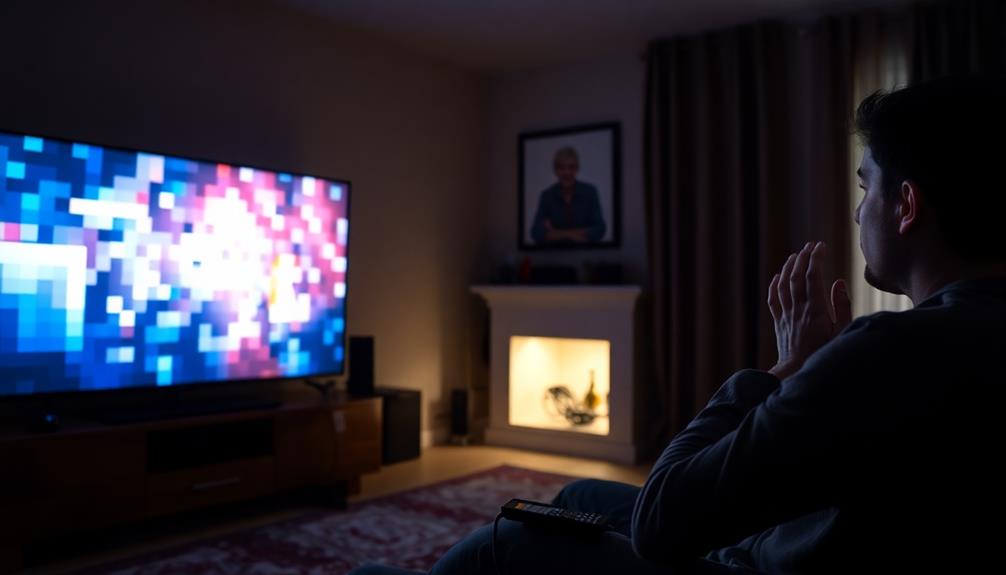
Video quality problems can greatly diminish your home theater experience. To enhance your viewing pleasure, consider the following steps:
1. Check connections: Verify all video cables, like HDMI or component cables, are securely connected. Loose connections can lead to signal loss and affect clarity.
Additionally, using high-quality cables can guarantee better signal transmission, similar to how selecting best vacuums for dust removal enhances cleaning efficiency.
2. Adjust resolution settings: Make sure the resolution settings on your devices match the capabilities of your display. This alignment is vital for peak picture quality.
3. Modify device settings: Tweak the brightness and contrast settings on your television or projector. Proper adjustments can considerably enhance visual clarity and detail.
4. Look for firmware updates: Regularly check for firmware updates for your devices. These updates can improve compatibility and overall video performance, addressing some underlying issues.
If you're still experiencing persistent video quality issues, it might indicate deeper problems. Faulty cables or malfunctioning hardware may require replacement or repair.
Compatibility Concerns
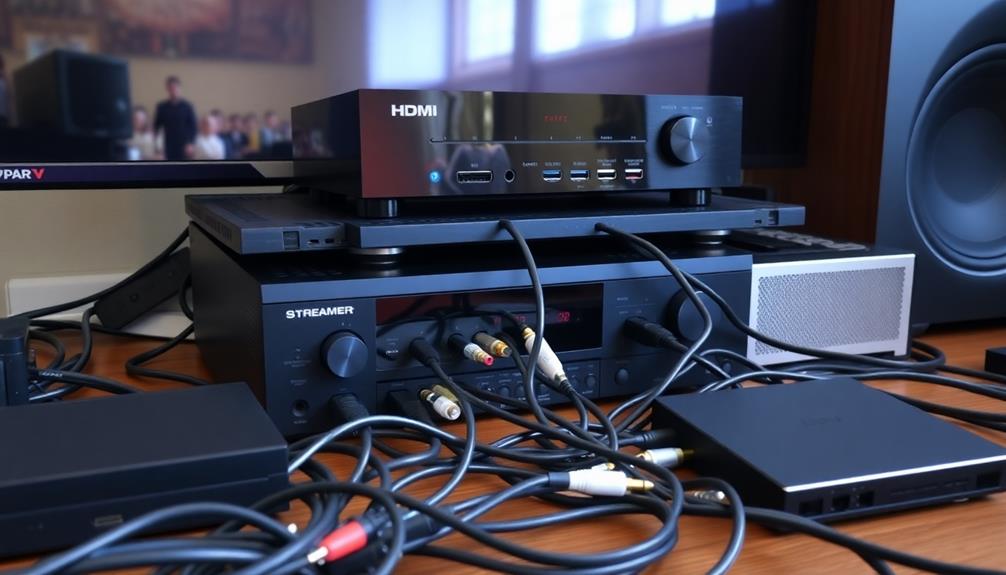
When setting up your home theater, it's vital to check that all your equipment is compatible with each other and the streaming services you plan to use. Not all devices support the same audio and video formats, which can lead to frustrating playback issues.
To guarantee smooth operation, consider optimizing your setup with essential upgrades and tools, such as using a high-quality HDMI cable for better signal transmission key skills for music production.
Make sure to verify that everything—from your receiver to your TV—works well together for the best experience.
Equipment Compatibility Check
To guarantee a smooth home theater experience, it's crucial to check that all your equipment is compatible with one another. Compatibility issues can result in poor audio and video performance, so follow these steps to guarantee a seamless home theater setup:
- Check HDMI Specifications: Make sure your devices support the required HDMI specifications, such as HDMI 2.0 or 2.1, for peak video and audio quality.
- Verify Audio Format Support: Confirm that your receiver or soundbar can handle the audio format of your source material—whether it's Dolby Atmos or DTS:X—to prevent playback issues.
- Update Firmware Regularly: Regular firmware updating can resolve compatibility issues and enhance functionality with newer formats and technologies. Always keep your devices updated.
- Confirm Reliable Internet Connection: A strong internet connection is crucial for streaming services. Check your router's performance and confirm it meets the speed requirements of your streaming devices.
Streaming Service Support
Even with compatible equipment, streaming services can present their own set of challenges. You might encounter compatibility problems that stem from unsupported formats or resolutions, like 4K or HDR, on your devices. Be sure to check that your smart TV, streaming box, or Blu-ray player has the latest firmware updates, as these can greatly enhance performance with your chosen streaming service.
To enjoy seamless streaming, verify your internet connectivity and bandwidth. Most streaming services recommend a minimum speed of 25 Mbps for uninterrupted 4K streaming. If you're using a receiver, check if it supports audio formats such as Dolby Digital Plus or DTS:X to achieve ideal sound quality.
Here's a quick reference table to help you troubleshoot:
| Streaming Service | Minimum Bandwidth | Supported Audio Formats |
|---|---|---|
| Netflix | 25 Mbps | Dolby Digital Plus |
| Hulu | 16 Mbps | Stereo |
| Amazon Prime Video | 25 Mbps | Dolby Digital Plus |
Remote Control Challenges
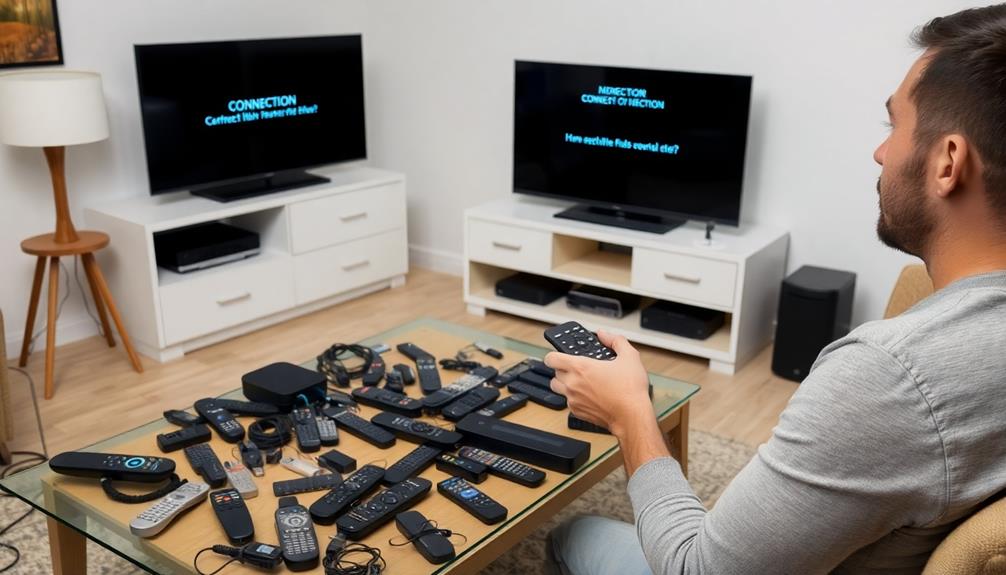
Remote control challenges can be frustrating, especially when your entertainment system refuses to respond.
When dealing with nonresponsive remote controls, you can follow these troubleshooting steps to get back in control:
- Replace the batteries: Depleted batteries are often the culprit. Make sure you've got fresh ones installed.
- Check for obstructions: Verify there are no objects blocking the line of sight between the remote and the device. This can hinder signal transmission.
- Reset to factory settings: If the remote still doesn't work, try resetting it to factory settings. This can often resolve any programming issues.
- Look for interference: Other electronics nearby might disrupt communication. Try relocating these devices or testing the remote in a different environment.
Audio Balancing Problems
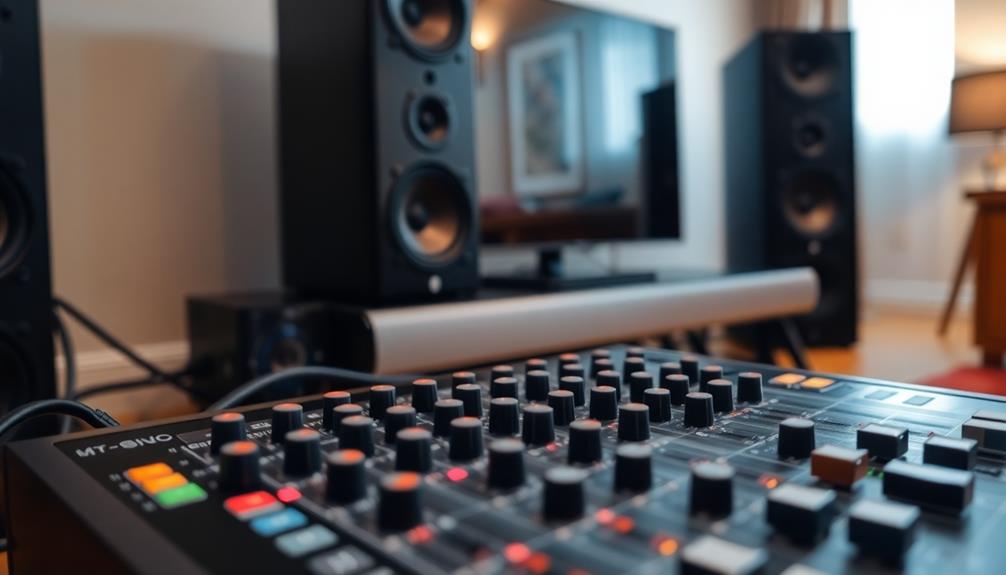
If you're struggling with audio balance in your home theater, it's time to adjust your receiver settings and optimize speaker placement.
Proper calibration techniques can make a significant difference in sound quality and distribution.
Don't forget to test the output after making changes to guarantee you've achieved that immersive experience you're after.
Adjust Receiver Settings
Adjusting your receiver settings can dramatically enhance your home theater's audio balance, making your listening experience much more enjoyable.
To tackle common sound problems, follow these troubleshooting tips:
- Utilize Built-in Equalizers: Most receivers come with equalizers. Fine-tune the treble and bass levels to correct overly bright or muddy sound.
- Recalibrate Speakers: Use the automatic setup feature to measure distances and levels for each speaker. This room correction optimizes audio performance relative to your listening position.
- Check Speaker Size Settings: Regularly verify if your speakers are set to Small or Large. This setting affects crossover frequency, which is vital for overall sound balance.
- Test Source Materials: After making adjustments, play various audio sources to evaluate their effectiveness. This guarantees your audio system delivers a well-balanced output.
Lastly, always verify your cables are securely connected to prevent any connectivity issues.
Speaker Placement Optimization
Achieving the best sound in your home theater hinges on proper speaker placement. Start by positioning your front speakers equidistant from the listening area and at ear level. This setup is essential for achieving the best sound.
Next, place your surround speakers slightly above ear level, ideally at 90 to 110 degrees from your listening position. This arrangement enhances immersion in surround sound formats.
For subwoofers, consider placing them in corners or along walls to maximize bass response. These locations can reinforce low frequencies through boundary loading, greatly improving your audio experience.
Experimenting with speaker angles and distances can lead to noticeable improvements in audio quality, as even minor adjustments can create a more balanced soundstage.
To guarantee your setup is perfectly tuned, utilize room correction software. This tool can help you fine-tune your speaker placement and settings, making sure that all speakers are properly balanced for a cohesive audio experience.
Calibration Techniques Explained
Calibrating your home theater system is essential for overcoming audio balancing problems and guaranteeing a rich listening experience. Proper calibration helps you adjust each speaker's output to achieve cohesive sound quality.
Here are some key techniques to take into account:
- Use Test Tones: Play test tones or utilize a calibration microphone to measure sound levels from each speaker. This helps identify discrepancies that need addressing.
- Adjust Speaker Placement: Confirm your front speakers are equidistant from your listening position, while surround speakers should be at ear level for ideal sound distribution.
- Evaluate Room Acoustics: Invest in acoustic panels and bass traps to mitigate echo and improve overall sound quality. Proper ventilation also contributes to a better listening environment.
- Reassess Regularly: Regularly check and adjust settings based on different source materials. This ongoing calibration process can lead to continuous improvement in audio balance.
Troubleshooting Techniques
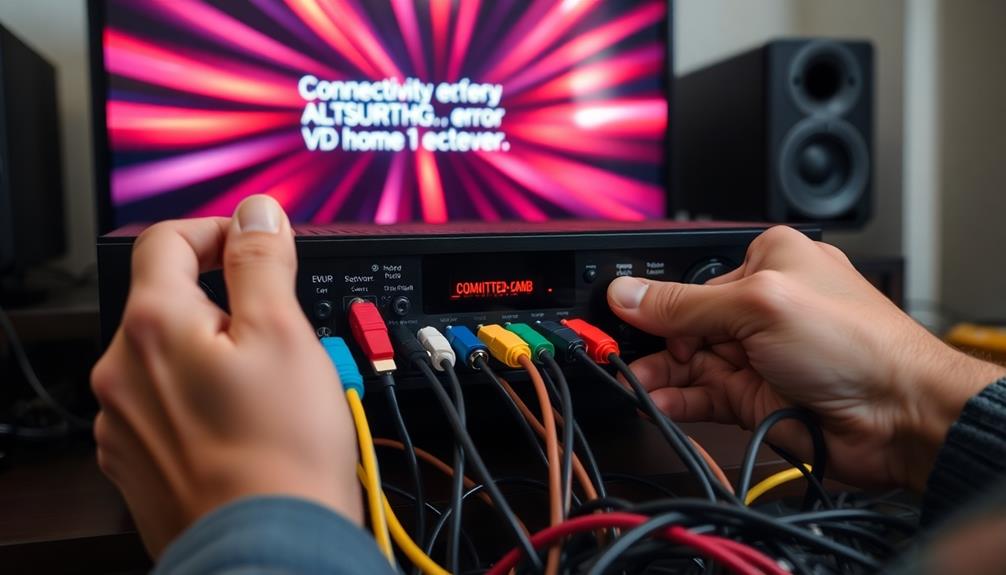
Effective troubleshooting techniques can greatly enhance your home theater experience. Start by checking all cable connections, including HDMI and audio cables. Make certain they're securely plugged in and free from damage to prevent connectivity issues in your home theater system.
Next, regularly update the firmware of your devices, like your AV receiver and smart TVs. This helps maintain compatibility and resolve any known issues.
If you're dealing with Wi-Fi connectivity challenges, consider optimizing your router placement or using a wired Ethernet connection for more stable streaming.
To tackle remote control problems, verify there are no obstructions blocking the signal path and replace the batteries if needed.
Frequently Asked Questions
How Do You Troubleshoot a Home Theater?
To troubleshoot your home theater, first check all cables for secure connections. Make certain the correct input is selected, power on all devices, and confirm your Wi-Fi network is working. Update firmware for better performance, too.
Why Are Some of My Home Theater Speakers Not Working?
Imagine your favorite movie, but the sound's missing. Check your speaker connections, verify settings match your setup, and test with known working speakers. A little detective work might just restore the cinematic magic you crave!
How Do I Reset My Home Theater System?
To reset your home theater system, power off and unplug all devices for 30 seconds. Then, find the reset option in the settings menu or use the reset button. Reconnect and recalibrate everything for peak performance.
Why My Home Theater Bluetooth Is Not Working?
Your home theater Bluetooth might not be working due to distance or interference, but don't worry; just check if both devices are on, paired correctly, and free from obstructions. A simple reset could help too!
Conclusion
In the grand symphony of your home theater, connectivity issues can hit a sour note, but don't let that steal your show. By tackling sound quality, video clarity, and compatibility concerns, you'll be back to enjoying your cinematic adventures in no time. Remember, even the best directors face a few bumps in production. With a little troubleshooting, you'll be ready to hit play on your favorite movies and let the magic unfold once again.
Hello, I’m Art, and I’m excited to be a part of the 1Home Theatre Projector team. As a writer, I’m here to contribute my knowledge and insights to help you achieve the ultimate home cinema experience. I understand that making decisions in the world of home entertainment can be complex, and I’m here to simplify the process for you.
